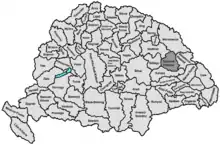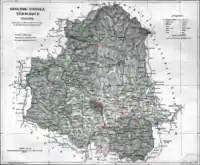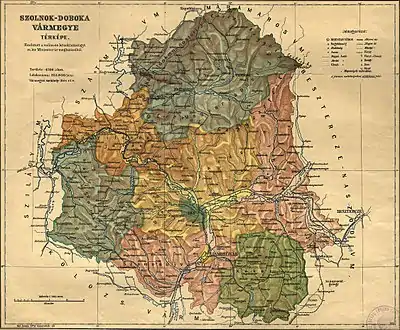Szolnok-Doboka County
Szolnok-Doboka was an administrative county (comitatus) of the Kingdom of Hungary. Its territory is now in northern Romania (northern Transylvania). The capital of the county was Dés (now Dej, Romania).
| Szolnok-Doboka County | |
|---|---|
| County of the Kingdom of Hungary (1876-1920, 1940-1945) | |
 Coat of arms
| |
 | |
| Capital | Dés |
| Area | |
| • Coordinates | 47°9′N 23°52′E |
• 1910 | 4,786 km2 (1,848 sq mi) |
| Population | |
• 1910 | 251936 |
| History | |
• Established | 1876 |
• Treaty of Trianon | 4 June 1920 |
• County recreated (Second Vienna Award) | 30 August 1940 |
• Disestablished | 1945 |
| Today part of | |
| Dej is the current name of the capital. | |
Geography
Szolnok-Doboka county shared borders with the Hungarian counties Szilágy, Szatmár, Máramaros, Beszterce-Naszód and Kolozs. The river Szamos flowed through the county. Its area was 4786 km² around 1910.
History
Szolnok-Doboka county was formed in 1876, when the county Belső-Szolnok was united with part of the Doboka region.
In 1920 by the Treaty of Trianon the county became part of Romania except from 1940 until the end of World War II, when it was returned to Hungary by the Second Vienna Award, it had then a modified territory. The territory of the county is now divided under the Romanian counties Cluj (the center and south, a.o. Dej), Maramureş (the north), Bistriţa-Năsăud (the east) and Sălaj (the west).
Demographics
In 1900, the county had a population of 237,134 people and was composed of the following linguistic communities:[1]
Total:
- Romanian: 180,309 (76.0%)
- Hungarian: 47,212 (19.9%)
- German: 7,252 (3.1%)
- Slovak: 390 (0.2%)
- Croatian: 212 (0.0%)
- Ruthenian: 123 (0.0%)
- Serbian: 4 (0.0%)
- Other or unknown: 1,632 (0.7%)
According to the census of 1900, the county was composed of the following religious communities:[2]
Total:
- Greek Catholic: 147,322 (62.1%)
- Eastern Orthodox: 36,247 (15.3%)
- Calvinist: 30,353 (12.8%)
- Jewish: 11,791 (5.0%)
- Roman Catholic: 9,164 (3.9%)
- Lutheran: 2,067 (0.9%)
- Unitarian: 154 (0.0%)
- Other or unknown: 36 (0.0%)

In 1910, county had a population of 251,936 people and was composed of the following linguistic communities:[3]
Total:
- Romanian: 189,443 (75.2%)
- Hungarian: 52,181 (20.7%)
- German: 6,902 (2.7%)
- Ruthenian: 154 (0.0%)
- Slovak: 42 (0.0%)
- Croatian: 9 (0.0%)
- Serbian: 7 (0.0%)
- Other or unknown: 3,198 (1.3%)
According to the census of 1910, the county was composed of the following religious communities:[4]
Total:
- Greek Catholic: 155,364 (61.7%)
- Eastern Orthodox: 38,608 (15.3%)
- Calvinist: 32,320 (12.8%)
- Jewish: 12,797 (5.1%)
- Roman Catholic: 10,522 (4.2%)
- Lutheran: 2,182 (0.9%)
- Unitarianist: 223 (0.0%)
- Other or unknown: 10 (0.0%)
Subdivisions

In the early 20th century, the subdivisions of Szolnok-Doboka county were:
| Districts (járás) | |
|---|---|
| District | Capital |
| Bethlen | Bethlen, RO Beclean |
| Csákigorbó | Csákigorbó, RO Gârbou |
| Dés | Dés, RO Dej |
| Kápolnokmonostor | Kápolnokmonostor, RO Copalnic-Mănăștur |
| Kékes | Kékes, RO Chiochiș |
| Magyarlápos | Magyarlápos, RO Târgu Lăpuş |
| Nagyilonda | Nagyilonda, RO Ileanda |
| Szamosújvár | Szamosújvár, RO Gherla |
| Urban districts (rendezett tanácsú város) | |
| Dés, RO Dej | |
| Szamosújvár, RO Gherla | |
References
- "KlimoTheca :: Könyvtár". Kt.lib.pte.hu. Retrieved 6 December 2012.
- "KlimoTheca :: Könyvtár". Kt.lib.pte.hu. Retrieved 6 December 2012.
- "KlimoTheca :: Könyvtár". Kt.lib.pte.hu. Retrieved 19 June 2012.
- "KlimoTheca :: Könyvtár". Kt.lib.pte.hu. Retrieved 19 June 2012.
